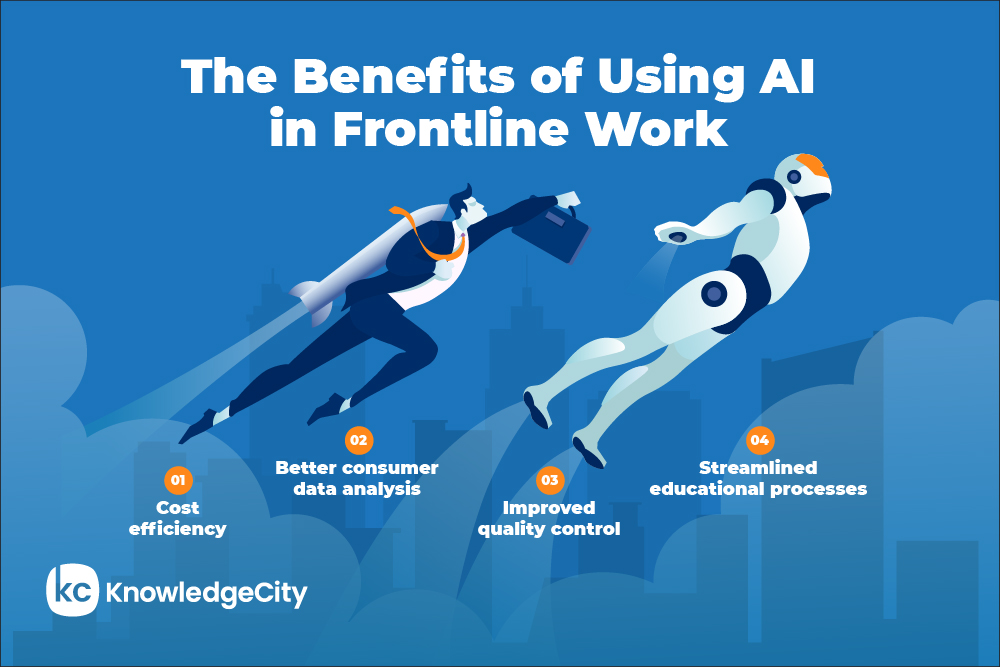Before the COVID-19 pandemic, the term “frontline workers” wasn’t well known.
Suddenly, people came to value the importance of frontline workers like few other human resources. Knowing not just the terminology but also what their names were, how many hours they worked in a week, what risks they took to do the work that couldn’t stop, and how tough their tasks could be without a reliable support system.

A good support system is critical in any environment, particularly one where conditions are changing rapidly, and the latest information is necessary to make critical choices that will affect others’ lives. As technology continues to accelerate, so does the value of using artificial intelligence (AI) as a support system for frontline workers.
The Crucial Role of Frontline Workers
The pandemic might have brought the importance of frontline workers into the limelight, but they’re hardly a new addition to society. They appear at the forefront of critical tasks, vital roles, and key industries worldwide.
Frontline workers provide services to the general public that are considered essential or crucial. There’s a distinction between frontline workers and essential workers, however. Someone might work in a power plant or at a water company and be essential, but they’re still not considered a frontline worker.
What’s the difference? It all comes down to how much contact the worker has with other people in a face-to-face environment.
Here are some common roles of frontline workers and fields that they frequently populate.
Local and national government: Includes federal government workers across all departments, along with elected officials and other politicians.
Education and child care: Teachers, day-care professionals, and special education professionals, along with specialists like speech-language pathologists and physical therapists.
Transportation: Anyone who interacts with passengers or travelers in water, road, rail, and air, like:
- Ticket agents
- Pilots
- Drivers
- Conductors
- Baggage handlers
Public safety: These workers include law enforcement, military forces, national guard positions, firefighters, and other forms of security workers.
Retail workers: Every consumer good starts at a factory, then moves to a warehouse, then is transported to the store where it will be sold.
Utilities and communications: Oil, gas, and electrical workers are on the scene to ensure distribution is working accurately. Communications technicians, decision-makers, and repair people are vital during times when travel and face-to-face abilities are limited.
Financial services: Your debit card might work 24 hours a day, but the financial services industry is run by real people performing cybersecurity and making lending decisions. They are also heavily involved in multiple aspects of customer service.
We tend to think that frontline workers only exist in high-stress situations, but they exist everywhere, from driving trucks and working in factories to educational institutes and hospitals.
Frontline workers are constructing buildings, working in warehouses, taking your order at restaurants, and painting your nails at beauty salons. They make up about 42% of the entire workforce. They’re not a specialized niche but rather an integral component of what makes our daily lives. If these workers took two days off, the repercussions would be felt for a month. They’re a vital cog in our society.
How Can AI Affect Frontline Workers?
We’d like our frontline workers to be able to perform their jobs better all the time, not just in times of crisis. To this end, we look to the potential collaboration of frontline workers and AI to allow these workers to do their jobs and thrive in their roles.
Everyone knows what AI can do from a data standpoint and what its algorithmic powers can do as resources for shoppers, but analysis is just one piece of the puzzle.
An overlooked component is how frontline retail workers can enhance their productivity and efficiency, especially when in a face-to-face situation with customers.
No matter what industry they’re in, frontline retail workers face the challenge of delivering an amazing customer experience. Such an experience is when they can deliver precisely what the customer wants and rapidly narrow down the best item based on specific customer choices and trends. This is one of the toughest things that frontline workers have to deal with when customers are used to shopping online.
Thanks to highly sophisticated algorithms and data-gathering capabilities, when customers return to an app or a website online, it’s like they’re reconnecting with a salesperson they’ve known for years. Their previous thoughts, choices, views, and unpurchased carts can be at frontline workers’ fingertips.
For healthcare workers who deal directly with patients and those who coordinate care, AI can be effective in streamlining the process of getting patients diagnosed, making sure their insurance covers treatment, and administering that treatment.
Medical data can be a complicated subject because of all the regulations that must be enforced, such as:
- Who can view and use it
- How long it can be used for
- How it must be disposed of
Considering how rapidly COVID-19 ravaged the American medical community a few years ago, moving quickly with all stakeholders on the same page could be a lifesaver.
Frontline workers also work behind the scenes, like in factories where productivity and efficiency mean the difference between necessary products arriving on time versus coming too late, which can cause huge problems for retailers and consumers.
Where human hands once worked as quickly as they could, now robots and other automated equipment are taking over, ensuring that humans can take on more beneficial tasks and also largely eliminating the need to change shifts and take breaks.
This AI efficiency greatly improves quality control across the board. Smart sensors on critical pieces of equipment allow workers to know when vital components need serving or replacing, often before they become a problem, which greatly reduces downtime on the factory floor.
We all saw how COVID-19 disrupted the education process. Some schools transitioned to remote learning, and many colleges and public schools didn’t start back up in person until the following year. Teachers and educators at every level were stifled by limitations on how they could teach and interact with their students.
Education can be significantly upgraded with the assistance of AI-powered virtual teachers who can handle bureaucratic and administrative-level duties—like grading tests, answering student requests, assigning homework and reading assignments, and reminding students of deadlines for various projects.
Even now, we’re just scratching the surface of using AI for learning and development, both in the classroom and the workforce.
Social workers are some of the frontline workers who get overlooked in times of crisis, especially in a situation like COVID-19, where people suddenly realize how vital face-to-face care and focus are. Going on home visits to assess the safety and well-being of children, the elderly, and other groups is something we take for granted until we can’t do it.
AI can quickly scan and parse documents from all different sources and compile records that give the local authorities and individual agents the best way to compile information. Doing so could mean the difference between someone getting the care they need in a timely fashion versus having to do without.
The Positives and Negatives of AI
The biggest benefit of AI for frontline workers is the ability to save both money and time by being more efficient. AI allows workers to do tasks that are more suited for human engagement, such as customer service, high-level strategy decisions, and more.
Not only does this leave employees fresh for more mentally challenging and satisfying tasks, but it ensures that a company’s products meet quality and safety standards on a much more consistent basis.
Among the largest challenges of AI are worries that have always been present when it comes to new technology. The first is that the AI will do its job so well that people will lose theirs as a result.
As much potential as AI has to impact a variety of industries, using it on an everyday basis is a challenge. There’s a wide gap that exists between how many employees know they’ll need it at some point and the number who know how to use it.
It appears that frontline industry leaders are taking care of their own education—about 44% of them have already gone through AI upskilling, but their employees are lagging significantly at just 14% trained. Upskilling is essential to bring any new technology into the mainstream of the workforce.
Expecting people to just “pick it up” isn’t enough for most of them to balance their already hectic workloads with taking on a new technology. For some, AI is revolutionary, but for others, it can be daunting.
How To Empower Frontline Workers Through AI
No matter what era your employees are from, AI can be overwhelming. After all, it has the ability to emulate human speech, carry on lifelike conversations, and create images, logos, prompts, and reports. It can free up time that used to take hours, if not days or weeks, for humans to perform those tasks.
While some people fear what AI might mean for the future of the workplace, its benefits are starting to outweigh its complications for more and more people. In a 2023 survey, 71% of respondents said they think the rewards of generative AI will outweigh the risks, but approximately four out of every five respondents agreed that there must be specific regulations put in place to keep that worry from becoming a reality.
There are two components that companies must focus on to give their frontline employees the best chance at using AI.
The first is to give employees ample space to experiment with AI. One of the most exciting things about the technology is that its limits are few and far between. This can be great for innovation and creative thinking, but it may cause confusion and frustration if users can’t figure out how to use the application properly.
The more opportunities frontline workers have to get familiar with AI, the better it will respond to them. This involves putting the application through trials so it can learn the user’s own patterns and behaviors. It also helps the user familiarize themselves with the program and how to yield the intended results with it.
The second is to prioritize acquiring and maintaining an AI program that’s responsive and responsible. We’re already seeing lots of instances where AI is being used for less-than-moral purposes, such as scam phone calls, fake news, and cybersecurity.
These issues can wreak havoc on what’s real and what is AI-generated, as we have seen with fake images and videos passed off as real online. The leadership of each frontline company must make specific cultural investments into ensuring that the technology is not being used for nefarious purposes and that the people using it are aware of its abilities and limitations.
Conclusion
The professional lives of frontline workers are never easy. Whether they’re the contact point for their brands in a retail setting, emergency workers being first on the scene of stressful situations, doctors and nurses fighting a pandemic on its front lines, or technical workers keeping the electricity and water flowing during weather-related disasters, they’re always expected by the rest of us to be at the top of their game.
Providing them with the necessary technology, tools, and training can help lead the way toward a future where they exceed every expectation.
Subscribe to Our Newsletter
Join 80,000+ Fellow HR Professionals. Get expert recruiting and training tips straight
to your inbox, and become a better HR manager.

 Nick Georgandis
Nick Georgandis 


